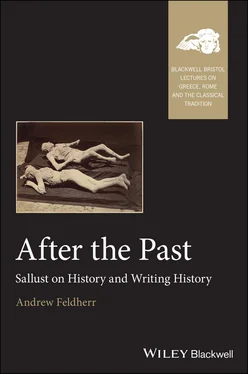1 ...7 8 9 11 12 13 ...20 I begin with a couple of preliminary observations to confirm that the audience’s sense of where they stand in time is an issue that matters in Sallust. First, that partial viewpoint of an immediate audience in the final sentence of the Catiline gains yet further power by contrast with the work’s opening. Sallust begins the monograph with a description of omnis homines —all humans, not particular humans, nor even Romans—and treats them as objects of description more than as subjects: what men ought to do turns out to be very different from what they actually do. The verb of that sentence is also in the present tense, implying not so much that the claim he makes is true “now,” but that it is always true:
Omnis homines qui sese student praestare ceteris animalibus summa ope niti decet, ne vitam silentio transeant, veluti pecora quae natura prona atque ventri oboedientia finxit. sed nostra omnis vis in animo et corpore sita est: animi imperio, corporis servitio magis utimur; alterum nobis cum dis, alterum cum beluis commune est. quo mihi rectius videtur ingeni quam virium opibus gloriam quaerere, et, quoniam vita ipsa qua fruimur brevis est, memoriam nostri quam maxume longam efficere. nam divitiarum et formae gloria fluxa atque fragilis est, virtus clara aeternaque habetur . ( Cat . 1.1–4)
All human beings who desire that they stand ahead of other living creatures ought to strive with the greatest effort not to pass through life in silence as the herds, which nature has formed as downward looking and subservient to their stomachs. All our power is placed in mind and body; we employ the ruling power of the mind, the slavery of the body. The one we share with the gods; the other with beasts. Therefore, it seems more upright to me to seek glory with the resources of talent than strength, and, since the life we enjoy is short, to make the remembrance of us as long lasting as possible. For the glory of wealth and beauty flows away and breaks; virtue is held (as) bright and eternal.
A glance back at the work’s beginnings from its ending makes clear how it has combined a focus on a specific point in time with the fragmentation of perspectives that lead from all humans to the partial and partisan view of the battlefield; as I will discuss more later, this process takes the reader into history, both as a genre and an awareness of how one’s place in time affects perception.
My second point moves from narratology’s concern with point of view to the schemata the text creates simply for measuring and understanding time. In a narrative like Livy’s, structured around changing years marked by naming consuls, you always know where you stand. 5Even if consular dating provides a notoriously awkward system for relating events to one another, for visualizing the hundred years between the defeat of Hannibal and the defeat of Jugurtha, it creates a powerful sense of a shared experience of the past measured through Roman political institutions. Sallust too seems to mark this tradition by beginning the first action of the story of the conspiracy proper with a specific consular date, the Kalends of June when Caesar and Figulus were consuls (17.1). But as the notice that this is June 1, not January, may suggest, we are already in medias res . For Sallust has provided his own account of the first beginnings of the conspiracy and located them in two contrasting frames of reference for understanding time. First, these events which we could measure from the middle of the consulate of Caesar and Figulus become manifestations of causes better traced through the life story of Catiline, and Sallust similarly imposes a biographical structure to his narrative, by beginning the story of Catiline at his birth and ending with his death. These causes must also be explained by a longer digression on the development of the republic, one that does not emphasize its extent through the proliferation of named magistrates but collapses that history into a short story. Its pattern moreover seems not distinctively Roman but comparable to what other empires have experienced.
But Sallust’s use of consular dating not only contrasts the shared Roman convention for measuring the extent of time with the alternatives of a life story and a universal pattern of rise and decline. The consular date is itself made part of the narrative in a way that connects its use with a sense of belonging to the res publica . Catiline’s plot aims at his obtaining a place for himself in the Roman fasti by becoming consul. When Catiline outlines his plans for the future, beginning with the programmatic “new accounts,” he ends with the promise that he as consul, with his partner Antonius, will make a beginning of action, of doing:
tum Catilina polliceri tabulas novas, proscriptionem locupletium, magistratus sacerdotia rapinas alia omnia quae bellum atque lubido victorum fert. praeterea esse in Hispania citeriore Pisonem, in Mauretania cum exercitu P. Sittium Nucerinum, consili sui participes; petere consulatum C. Antonium, quem sibi collegam fore speraret, hominem et familiarem et omnibus necessitudinibus circumventum; cum eo se consulem initium agundi facturum . ( Cat . 21.2–3)
Then Catiline promised cancelation of debts, the proscription of the wealthy, magistracies, priesthoods, plunder, and all the other things which war and the pleasure of the victors brings; besides, Piso was in Nearer Spain and P. Sittius Nucerinus in Mauretania with an army, both fellow conspirators; C. Antonius was also seeking the consulate, whom he hoped to have as a colleague, for he was both a close friend and a man beset by every sort of need; he himself as consul with this man would make a beginning of action.
Here is a counterfactual consular date that would provide not only the beginning of an ideal historical subject, a deed, but perhaps would restart a new res publica . Sallust’s choice of the conspiracy as a subject depends on “the newness of the crime and the danger.” Newness here implies a contrast with the old, with the Roman past constituted as a norm to measure Catiline’s exclusion from its traditions. But the Catilinarians themselves view time differently in looking not backward but forward to this new beginning. The conspirators see the promise of living after the past as positive good. And we may contrast Cicero’s efforts to ensure that any sense of the conspiracy as a new beginning was contained and refuted by his own consular insistence on precedent (cf. Cic. Cat . 1.3–4). Far from being really new, Catiline was just another rebel, with all too many antecedents in the early republic, each checked by the appropriate consul. And so the defeat of this conspiracy is both assured by the past and destined to take its place “in the date of my great consulate” (Juv. 10.122), within the ongoing flow of time that the open annalistic form guarantees. The consul, and consular dating, equally defeat Catiline.
Mention of Catiline’s implicit promise to refound the republic provides an appropriate cue for the entrance of the actual liberator, Marcus Junius Brutus. I will later return to Brutus’ potential similarities to Catiline, but for now I want to compare him not to the work’s protagonist but to its author. It may seem that Brutus can best illuminate Sallust by contrast: Brutus was an active figure who aimed to free the republic through his deeds; Sallust can be a historian because he already possesses a “free mind,” animus liber , one achieved through his own escape from the partisanship of the republic ( Cat . 4.2). However, like so many of his contemporaries, Brutus also managed a varied and extensive literary production. 6And the particular works he wrote, historical epitomes, epideictic works, including a life of the Younger Cato, and philosophical treatises on duties, virtue, and endurance, echo precisely the generic alternatives that especially complicate a sense of time in the Catiline . Is Sallust’s work an excerpt from Roman history, an epideictic life of its protagonist, or a treatise on virtue? The accomplishments of Brutus the author remind us that these were no abstract categories but important and proliferating forms of literary composition in the decade when Sallust worked. Sallust places his Catiline between all these writings, offering each as a competing template for understanding his own priorities. But a focus on Brutus also allows us to measure the aims of these literary exercises together, to give a snapshot of what writing at Rome was for, and to make clear how all these forms themselves mirror different understandings of the relationship between past and present.
Читать дальше












